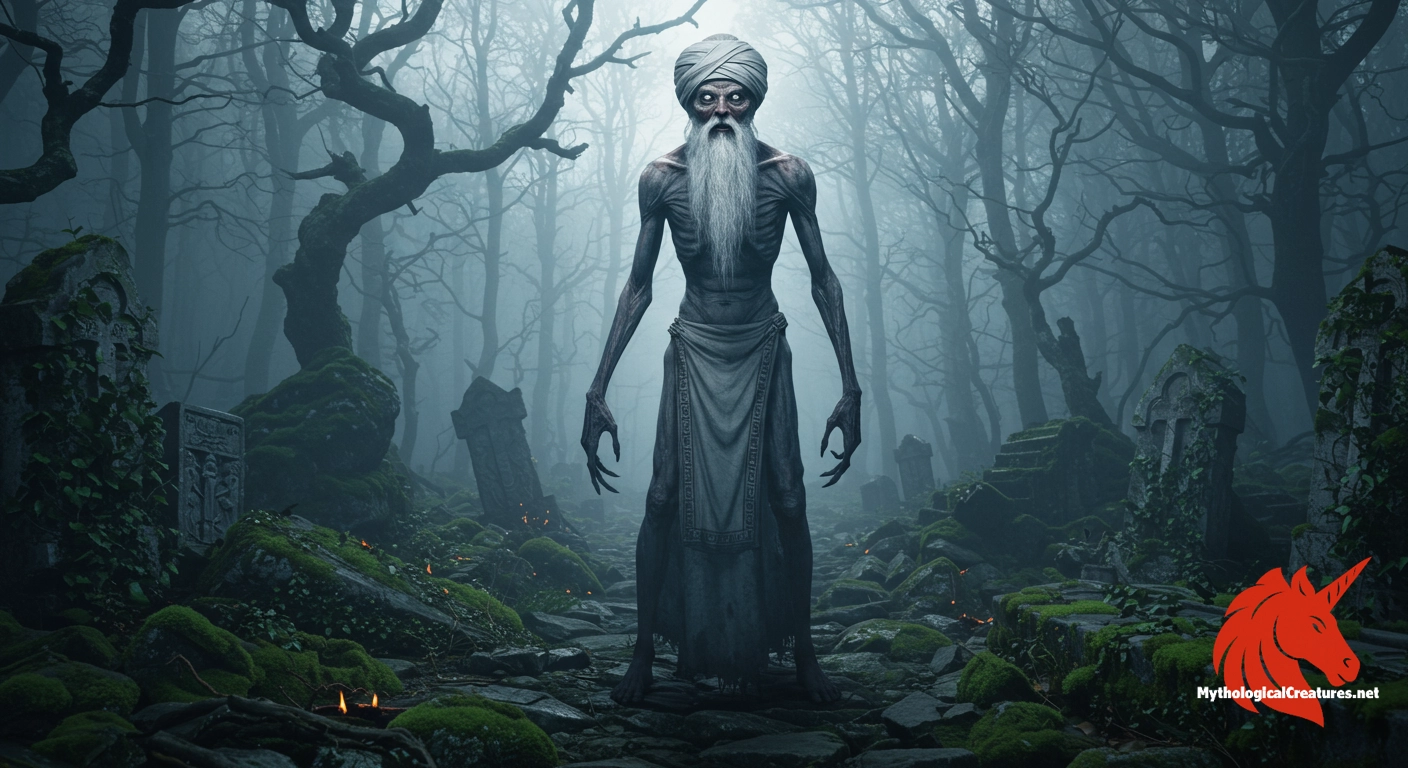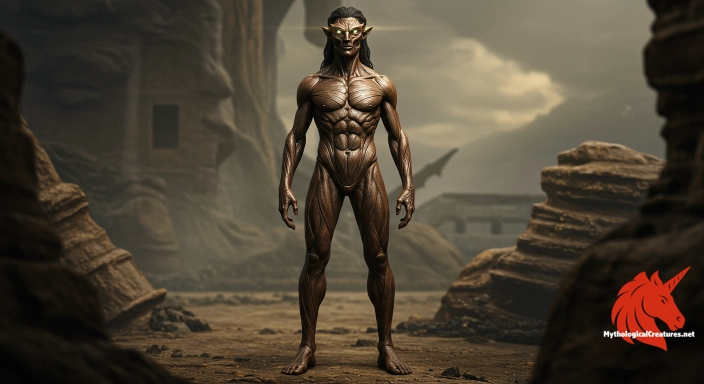Peckols: Peckols is a fearsome pagan Prussian deity of the underworld.

Peckols
Peckols - A fearsome deity who enforced proper burial rites and punished the living, reflecting the deep-rooted underworld beliefs of the Old Prussians.
Origins & First Encounters
Peckols is one of the most enigmatic figures in the ancient Prussian pantheon, a deity whose essence permeates the shadowy realms of the underworld and the mysteries of mortality. His identity, often interwoven with that of Patollo, reflects the fluidity of pagan beliefs in a period of profound cultural transformation. Emerging from the deeply spiritual practices of the Old Prussians, he was revered as much for his fearsome temper as for his role in guiding the dead to their destiny. He is portrayed as a powerful, dual-natured entity, capable of both punishing transgressions and governing the thresholds between life and death. The earliest attestation comes from a 1418 letter written by the Bishop of Warmia, marking the beginning of his documented legacy. Over time, his depictions evolved to capture the intensity of ancient rites and the inescapable presence of death in everyday life. The character of Peckols embodies an intersection of dread and divine authority, which resonated with communities confronting the uncertainties of existence. As such, his myth continues to evoke fascination and introspection about the human condition in the face of inevitable mortality.
Source Texts & Tale Variants
The primary records of Peckols’ legacy are as varied as they are intriguing, with the first notable mention appearing in a 1418 letter from the Bishop of Warmia to the Pope. This early reference set the stage for further elaborations by later chroniclers who sought to capture the essence of this formidable deity. In the early 16th century, chronicler Simon Grunau offered a vivid and detailed account that, though now considered somewhat dubious, enriched the tapestry of narratives surrounding the god. His writings describe Peckols, or Patollo, as a figure emblazoned on royal symbols, linking the divine with regal authority. The Sudovian Book of the 1520s introduced contrasting aspects by differentiating between the dark lord of the underworld and an airborne spirit associated with malevolent forces. Additional evidence comes from church decrees of 1530, where Peckols was equated with classic mythological figures such as Pluto and the Furies. Later writers like Alexander Guagnini, Lucas David, and Jan Sandecki Malecki further contributed to the evolving story, each adding layers of local flavour. In the 17th century, authors such as Christoph Hartknoch and Matthäus Prätorius confirmed that belief in this deity continued to shape popular folklore. The collected sources thus form a multifaceted record, revealing both historical continuity and the shifting sands of myth over centuries.
Form & Powers
Descriptions of Peckols offer a window into the symbolic imagery of a deity that embodies the stark realities of death and the supernatural. In some early accounts, particularly those influenced by Grunau, he is depicted as an elderly figure with a flowing white beard that conveys both wisdom and a chilling sense of foreboding. His white headdress, reminiscent of a turban, serves as a stark counterpoint to the dark realms he represents, hinting at an inherent duality. Artistic portrayals often imbue him with deep-set, intense eyes that mirror the mystery of the afterlife and an expression that can be both stern and sorrowful. Variations in his depicted size and stature further underscore the flexibility of his image, ranging from a diminutive, spectral presence to an imposing, larger-than-life overseer. In some renditions, his features are sharp and angular, suggesting an otherworldly, almost inhuman quality that intensifies his aura of menace. Other interpretations introduce elements such as flowing robes or even subtle hints of decay, thereby reinforcing his association with cosmic cycles of life and death. The blend of regal attributes with spectral motifs creates a composite image that is as multifaceted as the myths themselves.
Regional Faces
Across the historic regions once inhabited by the Old Prussians, the lore surrounding Peckols is imbued with local nuances and interpretative variations. In some areas, he is considered a singular, all-encompassing god of the underworld, while other traditions bifurcate his identity into two distinct yet complementary beings. In neighbouring cultural spheres, especially among Lithuanians, parallels can be observed with deities like Velnias, whose characteristics echo Peckols’ fierce and vengeful nature. Folk traditions in western parts of the region have adapted his imagery to reflect both the harshness of nature and the societal importance of ancestral rites. Regional festivals and local storytelling have often reimagined him as a guardian of moral order, ensuring that proper burials and rituals are observed. The variations in his depiction are closely tied to the intersection of native pagan practices with the encroaching influence of Christian doctrine. In some localised myths, the deity takes on a more benevolent aspect when honoured correctly, highlighting the complex interplay between fear and reverence. These diverse regional adaptations underscore the fluidity of myth as it traverses different cultural landscapes and historical periods.
Cultural Parallels
Peckols occupies a fascinating position within the broader spectrum of Indo-European myth, inviting comparisons with several similarly themed deities from neighbouring cultures. His role as a ruler of the underworld brings to mind the Roman god Pluto, as well as the shadowy figures inhabiting Greek myth, such as the Furies, whose presence is equally formidable and cathartic. Parallels with the Lithuanian Velnias further highlight a shared mythological thread that spans across Eastern Europe, reflecting a common cultural response to the mysteries of death. These comparative figures are united by themes of retribution, the regulation of cosmic order, and the inevitable encounter with mortality. The overlay of both benevolent and malevolent qualities in these deities suggests a universal attempt to reconcile the certainty of death with the need for moral accountability. Despite variations in cultural context, the visual and symbolic motifs associated with these gods remain strikingly consistent. The integration of elements such as dark attire, spectral auras, and transformative powers further reinforces the connections between these mythological traditions. Ultimately, assessing Peckols alongside his counterparts deepens our understanding of how ancient societies grappled with the metaphysical dimensions of existence.
Legacy & Modern Evolution
The legacy of Peckols has evolved over many centuries, reflecting changes in religious thought and societal attitudes toward death and the supernatural. Once a central figure in the pagan rites of the Old Prussians, he has gradually transitioned into a symbol that captures the complex interplay between fear and respect for the unknown. As the influence of Christianity spread, his role and image were reinterpreted, merging elements of pagan mystery with emerging European religious narratives. In subsequent eras, his story was continually reshaped by historians, folklorists, and chroniclers, each adding layers of meaning to his character. Modern literary and artistic explorations have revived interest in his myth, portraying him as a compelling archetype of the enigmatic and inevitable forces of decay and renewal. Contemporary interpretations often focus on his dual nature, exploring the tension between divine retribution and the natural cycle of life and death. Community heritage projects and cultural festivals in parts of the former Prussian lands still evoke his memory, serving as a bridge between ancient myth and modern identity. In art and literature, the figure of Peckols provides a rich, evocative symbol that challenges audiences to contemplate the mysteries inherent in human mortality. His enduring legacy is a testament to the power of myth to adapt and resonate through the ages.
Interesting Fact
Peckols is often equated with Roman Pluto and shares similarities with the Lithuanian Velnias, highlighting the syncretic nature of ancient European underworld deities.
Quick Creature Info
Associations:
Our Mythic Legendary Rating:

Also Sometimes Known As:
Habitat:
Supernatural Powers:
Physical Attributes:
Abilities:
Behavior:
Lore:
References
Discover Another Mythical Legend You May Not Have Heard Of?
Uncover the mysteries of ancient folklore and expand your knowledge of legendary beings from cultures around the world.
Dare to Meet the Milcom....
Mythical Disclaimer: The images and data on this site are derived from various historical and literary sources, but we have found that many myths often have multiple versions and interpretations across references, sometimes contradictory. As a result, these creature depictions are artistic interpretations—imaginative blends of folklore, legend, and a dash of AI guesswork. Because creature descriptions vary widely, our illustrations and accompanying information represent our best effort to honor mythology while bridging creative gaps. Enjoy these interpretations—just remember, we've done our best to respect the stories and validate available data, but in the realm of mythology, details often shift, imagination leads the way, and nothing is ever set in stone!
Curated by the Mythological Creatures Team (rev. May 2025)
